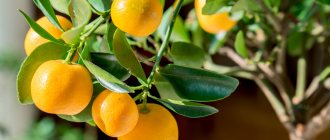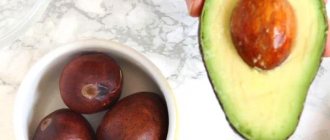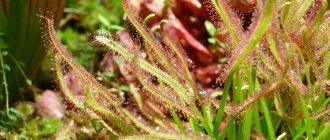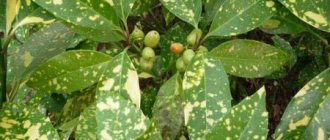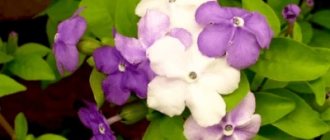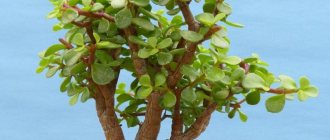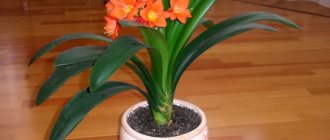Gardening » Citrus
0
1094
Article rating
Kira Stoletova
Citrofortunella, or calamondin, is a small citrus tree native to Asia. In our area it is grown in greenhouses, greenhouses or apartments. The plant blooms and bears fruit indoors. Caring for calamondin at home is not difficult: the species is not particularly demanding.
Caring for calamondin at home
Description and characteristics of the plant
Calamondin citrofortunella microcarpa is a hybrid crop developed by crossing a tangerine and a kumquat (fortunella).
Citrus belongs to the rue family. At home, in Southeast Asia, the tree can reach seven meters in height.
At home, the height of an adult plant does not exceed 120 cm. The oval-shaped leaves are dark green, dense, and glossy.
White star-shaped flowers exude a delicate aroma. Mass flowering occurs in the spring and summer months; single buds appear even in winter.
Citrofortunella differs from its relatives in that it does not have thorns on its shoots.
Under favorable conditions, calamondin bears fruit all year round.
Fruits weighing 10-20g are similar to small tangerines. The fruits are edible, but not everyone likes the bitter-sour taste and the abundance of small grains.
Calamondin flowering
Lychee from seed at home - growing and care
There are many varieties of calamondin that can be successfully grown indoors. The main difference between them is the appearance and taste of the fruit. Flowers can differ only in the shades of the petals - from white to cream.
There are a few particularly noteworthy species.
- Margarita Nagami. The fruits are more like orange in color and lemon in taste.
- Margarita Big. The pear-shaped fruit is a distinctive feature of this variety.
- Maeva. The advantage is the sweet taste of the fruit and the absence of seeds.
- Tiger. A special feature of the variety is the unusual color of the leaves - they have a golden rim along the edge.
- Centenial. During fruiting, unusual fruits appear on the bush, resembling watermelons in appearance.
Picture 5 The Senteniel variety amazes with the appearance of its fruits
There are many other varieties, each of which has its own advantages. For example, for those who love flowering calamandin, the Peters variety is a good choice. It blooms profusely and beautifully, but its fruits cannot be called tasty.
Calamondin after purchase
Plants from the store will require special attention, since they are grown using special technology. In addition, conditions change, and the indoor mandarin must adapt to them.
Adaptation
When purchasing a new plant, you need to create a microclimate for it at home that is similar to the previous one. It is also advisable to orient it in relation to the light source, protect it from drafts and maintain the frequency of watering.
Changes in temperature, light and air humidity negatively affect the condition of the plant. The leaves lose their shine, turn yellow and fall off. In this case, it is necessary to take urgent measures:
- create greenhouse conditions (put on a transparent plastic bag);
- ventilate the bush twice a day, removing the bag;
- water moderately, but do not allow the soil to dry out;
- with sufficient lighting, avoid direct sunlight;
- in winter, organize additional artificial lighting.
A sign of recovery will be the appearance in 10-15 days of young shoots and leaves.
Transfer
Two weeks after purchase, it is recommended to transplant the citrofortunella. A small store pot should be replaced with a container 3-4 cm larger in diameter. A tree or bush will grow better in clay or wooden containers. If the flowerpot is plastic, the drainage layer should be thicker.
The root system must be carefully examined and rotten roots removed.
After transplantation, calamondin may lose its leaves. To preserve nutrients, it is better to remove the fruits. You can shorten the branches by sprinkling the cuts with activated carbon powder. It is useful to use medicinal solutions for spraying.
Problems when growing citrofortunella
The question most often asked by gardeners is: what to do if calamondin sheds its leaves and its branches dry out. But when cultivating it, other problems are possible:
| Description of the problem | Possible reasons and recommendations |
| Leaves turn yellow, shoots dry out | High air temperature, low humidity, direct sunlight, infrequent watering. It is necessary to identify and eliminate errors in care. |
| The base of the stem rots, “wetting” spots appear on the leaves and shoots | Excess moisture combined with low temperature. In advanced cases, the plant cannot be saved. If the problem is noticed at an early stage of development, cut off all affected leaves, branches, tissues on the trunk, optimize housing conditions, replace irrigation water with a weak solution of any fungicide for 5-8 weeks. |
| The fruits fall off without ripening | Nutrient deficiency, application of inappropriate fertilizers. Eliminate errors in care. Sometimes the plant naturally normalizes the yield itself. |
| The plant does not bloom | Incorrect maintenance conditions, most often – lack of light, unsuitable substrate, frequent moving of the pot for no reason. Eliminate errors in care. |
| Drops leaves | Drafts in the room, water with cold water. Negative factors must be eliminated. It happens that the cause is natural stress caused by transplantation and adaptation to new conditions after purchase. |
| Pest attacks (aphids, whiteflies, spider mites, scale insects, false scale insects) | Pests are visible to the naked eye; it is necessary to inspect the plant regularly. Having discovered a problem, if possible, collect the insects by hand, treat the calamondin with soap foam, then with a suitable insecticide or acaricide. |
| Fungal diseases (leaf wilting, spots on them) | Regular inspection of the plant is recommended - this way the disease can be detected at an early stage. All damaged tissue should be cut off, the “wounds” should be sprinkled with crushed chalk or ash, and the plant and soil should be treated 2-3 times with a solution of any fungicide. |
Yellowing calamondin leaves are most often a consequence of the gardener’s mistakes in caring for it
Calamondin is an exotic citrus plant, successfully “domesticated” by amateur gardeners. Calamondin is valued for its visual attractiveness. The edible fruits are a pleasant bonus.
Calamondin species citrofortunella microcarpa
Citrofortunella does not differ in varietal diversity, since the crop was developed through selection.
Decorative properties predominate in variegated (variegated) varieties. Meiva and Margarita have good taste.
The most common varieties:
- Centeniel is a variegated variety. There are milky stains on the leaves. Unripe fruits look like small watermelons. As the fruit ripens, the stripes disappear and the skin turns bright orange.
- Tiger. The leaves are framed by a narrow golden border; The taste of the fruit is sweet and sour.
- Peters. Decorative variety with beautiful fragrant flowers; The fruits are small and very sour.
- Margarita Nagami. Frost-resistant variety. Fruits with lemon sourness ripen by the end of December.
- Maeva. Sweet citrus without bitterness; oval or round shape.
- Doll. The fruits are pear-shaped with sourness, the peel is sweet.
Obtaining fruits
As a rule, flower shops sell calamondins with fruits already hanging on their branches. When purchasing such a plant, remember that its fruits are most likely not ripe. In addition, you should take into account the fact that when you bring the tree home, its fruits may fall off.
If you purchased a young bush that does not yet bear fruit, then it is quite easy to make it bear fruit. The most important thing is to provide the bush with the most favorable conditions for growth. Do not forget to timely apply fertilizers to the substrate, provide high air humidity and a dormant period, and then this unusual citrus plant will delight you with its fruits.
After the fruits have ripened well, they are carefully trimmed and, if necessary, stored in a place where it is always cool. In order for the plant to bear fruit annually, you need to monitor the condition of its crown. Those stems and branches that have not produced fruit for the second year in a row must be cut off.
Caring for calamondin at home
Indoor tangerine is often grown as an ornamental crop. In this case, you need to immediately begin forming the crown.
To get a citrus harvest, it is important to regularly apply fertilizers and fertilizing during the period of active flowering and fruit set.
Location and lighting
Citrofortunella is best grown on the east or southeast side of the house. A mature plant will tolerate a few hours of direct sunlight, but not the summer heat.
Sunburn will not only damage the leaves, but also weaken the entire plant.
If the window faces south, a light-protective film is glued to the glass. You can take the tree to a balcony or loggia, providing diffused lighting.
In winter, it is good to use additional artificial lighting for fruit-bearing crops, extending daylight hours to 10-12 hours.
Calamondin does not react well to changes in location. For uniform growth of shoots, the pot is turned clockwise daily, but no more than 10-15° per week.
Temperature
The optimal regime for citrus fruits during the growing season is from +18°C to +26°C. The peculiarity is that the temperature in the area of the crown and root system should be approximately the same.
To prevent the roots from overheating, you should choose a light-colored pot or wrap the pot with a sheet of white paper. If the flowerpot is on a heated floor, you should lift it (place it on a grate).
In winter, it is recommended to ensure a temperature regime not exceeding +18°C. A dormant period with a temperature of +10-12°C allows you to increase the yield next year.
A decrease to +2-3°C is dangerous even for frost-resistant varieties.
Watering and air humidity
The soil in the flowerpot should be kept moist at all times. When the top layer dries a centimeter and a half, the soil must be shed until water appears in the pan. It is better to drain the excess so that the roots do not rot. Water for irrigation should be left for at least 24 hours in an open container.
The foliage needs to be sprayed daily with a spray bottle.
In winter, the frequency of watering is reduced, and air humidity must be increased. Special devices, containers with water or a wet towel on the heating radiator will help with this.
Feeding and fertilizers
With the beginning of active growing season, it is necessary to regularly feed the tree 3-4 times a month. At a flower shop you can purchase complex fertilizers for citrus fruits or a composition for flowering plants.
For root feeding, a 0.5% solution of ammonium nitrate with the addition of potassium chloride (2 g per liter) is suitable.
Special foliar fertilizers are also useful, which, after spraying, are absorbed by leaf tissue.
In winter, fruit-bearing calamondin can be fertilized once a month.
Pruning citrofortunella
A spherical bush or slender tree begins to form before the onset of the intensive growth phase. The procedure should be carried out in late February-early March.
In addition to being decorative, this is also a sanitary measure. It is acceptable to remove about 30% of the growth.
Remove dried and damaged branches, as well as those that break symmetry. In summer, long shoots are shortened by pinching.
How to vaccinate
Peculiarities. If calamondin is grafted correctly, it will be more drought tolerant and develop a good root system. Most often it is grafted onto orange seedlings. You can vaccinate at any time from March to the end of summer. During the period of active growth, the scions take root well and begin to grow.
Algorithm of actions
- The lower leaves and branches are removed from the rootstock and trimmed at the selected height.
- The rootstock is cut vertically to a depth of about 2 cm. The bark is separated from the wood.
- Select a suitable branch for the scion. A cut is made on the underside of the cutting.
- A cutting is placed into the vertical cut, clamped and wrapped with insulating tape.
- The junction is tightly wrapped with plastic film.
- After a month you can remove the polyethylene, after two - the insulating tape.
Vaccination is a rather complicated procedure. For beginners, it may not work out the first time. All the subtleties of vaccination can only be learned through experience.
Planned replanting of home tangerine
Gardeners advise planting seedlings grown from seeds or cuttings when they grow to 20-25 cm.
Young citrus needs to be replanted annually in early spring. A three-year-old plant is replanted after a year.
A large tree in a spacious tub does not need to be replanted; it is enough to replace the top layer of soil.
Each time it is recommended to increase the diameter of the pot by 5-8 cm.
For a healthy plant, a simple transshipment procedure is carried out. The entire lump of earth from the old dish is transferred to the new one. At the same time, beneficial saprophytic fungi that complement the root system are not damaged.
The soil mixture is prepared from turf soil (2 parts), humus (1 part) and coarse sand (1 part). The drainage layer is poured 3-4 cm thick.
The root collar should not be deeply buried; it is better to fill it with soil at the same level.
Seed and vegetative propagation
Calamondin propagates by seeds and cuttings. The first method is slow and labor-intensive. The second one is simpler. Each of them has its own characteristics.
Growing from seed
Peculiarities. Growing calamondin from seed is a long and labor-intensive process. Theoretically, calamondin will begin to bear fruit in six years, but in practice it takes ten years before the first flowering. Calamondin seeds lose their viability very quickly, so they need to be planted immediately after collection. The fruit is left on the tree until the last moment - it must be fully ripe.
Algorithm of actions
- Prepare a nutritious soil mixture. It is made up of fertile soil, sand and peat.
- Pour soil into a container, spread the seeds over the surface, and sprinkle them with a 1–2 cm layer of soil.
- The soil is well moistened with a spray bottle, the container is covered with film. Keep in a warm, well-lit place. The optimal temperature for seed germination is 25-28°C.
- After the shoots emerge, the film is removed. They are planted at the stage of two true leaves into separate pots.
Using the same principle, you can grow lemons and oranges from seeds. But the chances of success will be lower. Most fruits arriving on store shelves are picked unripe.
Cuttings
Peculiarities. Calamondin can be propagated by cuttings. Cuttings are cut in early spring from strong, healthy branches. The easiest way to root is apical cuttings with three to four internodes and fully mature leaves.
Algorithm of actions
- The cuttings are cut and the cut is dried for an hour.
- The lower part of the cutting is treated with a phytohormone solution and placed in light soil. Bury into the soil to the bottom leaf.
- The container with the cutting is covered with a jar. Maintain a temperature of about 24-28°C.
- Every day the shelter is removed for half an hour and the soil is moistened as necessary.
Rooting does not always occur, so it is better to use several cuttings at the same time. The first roots appear after two to three weeks. Calamondin, grown from cuttings, begins to bear fruit in the third or fourth year.
Reproduction of Calomondin
The lifespan of a homemade tangerine is short - 5-6 years, but the plant can be propagated and new specimens grown.
Growing citrofortunella from seed
This is the simplest method. However, citrofortunella grown from seeds begins to bear fruit after a few years, and sometimes does not bear fruit at all.
The seeds should be taken from fresh, well-ripened fruit.
Plant the seeds in a loose, fertile soil mixture, deepening them to 1 cm. After abundant watering, set up a greenhouse, covering it with a glass jar.
After a month and a half, sprouts appear. When 4-5 leaves develop on each, they are planted in separate pots.
Cuttings from homemade tangerine
Calamondin can be propagated by cuttings in late spring or early summer. You need to select a healthy branch with 2-3 buds closer to the top of the crown and cut it with a sharp knife.
For better rooting, the shoot should be soaked in a stimulant solution. The most commonly used are “Epin” or “Kornevin”.
Then the cutting is transferred to a pot with prepared soil and a mini-greenhouse is set up.
The place for the greenhouse should be bright. The seedling needs to be ventilated twice a day, removing the jar for 15-20 minutes.
With sufficient humidity and a comfortable temperature (+25°C), the plant will take root; after 3-4 weeks it can be transplanted into a pot.
Propagation by cuttings allows you to get the first harvest in the second year. Citrus retains its varietal qualities and does not require grafting.
How to care at home
It does not tolerate the change from the microclimate of a store to home conditions very well. For better adaptation, you can remove all fruits and flowers.
Temperature
This is a heat-loving crop that does not tolerate drafts or direct sunlight. The temperature in summer is up to 20 degrees, and in winter it is lower – up to 10-15 degrees. A slight difference is necessary for better fruiting. In summer they take it out onto the balcony, into the open air.
Loves the light
There is no need to rotate a flowering and fruiting plant often and much around its axis; you may lose flowers and fruits.
Irrigation scheme
In the summer, water abundantly, every day with warm water, and do the same in the spring, when growth begins.
In winter (starting from October), water rarely, once a week, avoiding drying out. It can lead to leaf and fruit drop.
Needs systematic spraying all year round (in winter with central heating). Dry air favors the proliferation of ticks and scale insects.
Replanting correctly
Transplantation is carried out in spring or at the very end of winter:
- While Citrofortunella is young, it is replanted annually, adult plants - after 2 or 3 years;
- The earthen ball is not destroyed, but the plant is handled;
- The root collar is at the same level as in the old pot;
- Trees without fruits and flowers should be replanted - they may fall off;
- Drainage is required;
- The soil is medium loose (a mixture of turf, leaf soil, humus and coarse sand), acidity 6-7 or a purchased mixture for citrus fruits;
- Trim long shoots to shape;
- It is advisable to choose containers made from natural materials.
Trimming
Every year, along with replanting, the plant must be pruned in the spring months. Leaves and young fatty shoots that prevent fruiting are removed. So, year after year, the plant acquires an oval, symmetrical shape.
What to feed
Feeding with microelements is necessary for an adult plant or one that has not been replanted for a long time. During the period of intensive growth and fruiting, feed twice a month with fertilizers for citrus crops (in winter - once). You need to add food after watering, but not earlier than a month after transplanting.
Reproduction in spring
- It is better to buy a grafted plant in the store. After grafting (you can graft it yourself onto any citrus tree), it takes root well and will bloom the next year;
- Cuttings. Calamondin propagated in this way will bloom in three years. Cut a 10-centimeter cutting, plant it in the ground and cover it, moistening it. It will germinate in 2 months. Cuttings do not take root well; you need to plant several at once and use phytogrowth stimulants to get results;
- Bones. The simplest method of propagation. Sow fresh, not dry seeds from ripened fruits to a depth of 2 centimeters. Moisten and cover with glass or film.
Remember! Calamondin grown from seeds will bloom only after 6-10 years.
Pests
The plant is affected by scale insects, spider mites and fungal diseases. You need to monitor the condition of your favorite plant, avoid drying out the air and soil and take timely measures:
- Once a month, wash the leaves and trunk with a solution of laundry soap or potassium permanganate (avoid contact with the soil). After the soap - a water shower of leaves;
- For fungi - good drainage at the bottom of the pot, a rusty nail in the ground. Root collar above the soil surface.
Diseases and pests of calamondin
Plants are more likely to suffer from pests and diseases if they are not properly cared for. A healthy, strong tree is less susceptible to disease.
Anthracnose
A dangerous fungal disease appears in the form of greenish or brown spots on leaves and stems. Dried leaves fall off, depressions form on the branches, disrupting the movement of plant juices.
In dry weather, cracks appear on the stems; at high humidity the shoots rot.
It is necessary to cut off all affected parts (twigs, ovary, fruits), then burn.
To treat anthracnose, use “Fitosporin-m” or a 1% solution of Bordeaux mixture. Prevention consists of timely fertilization with microelements.
Sooty fungus
Often, sooty fungus develops on the sticky secretions of scale insects. Respiration and photosynthesis of the leaf blade are disrupted.
Settling on tangerine leaves, the fungus spoils the appearance of the plant. Black plaque should be washed off with warm (+40-45°C) water. The room must be well ventilated.
Gommoz
Sometimes sticky brown droplets appear from a crack on the trunk, hardening in the air. This specific disease is gum disease (homosis). The cause may be excess nitrogen in the soil.
The wound must be cleaned, disinfected with a solution of potassium permanganate, and covered with garden varnish. It is important to provide favorable conditions: watering with warm water, good drainage, sufficient lighting.
Pests
The main enemies of citrofortunella are scale insects, spider mites, whiteflies and aphids.
To combat parasites, mechanical and chemical methods are used.
Leaves and shoots are wiped on all sides with a napkin soaked in a solution of green or laundry soap. A week later the procedure is repeated.
Soap-oil emulsions are effective (stir a spoonful of machine or burdock oil in a liter of heated soapy water).
Tar soap (10 g per liter of water) helps get rid of aphids.
For extensive lesions, it is recommended to use the drugs “Fitosporin”, “Calypso”, “Fitover”.
We create optimal conditions for growing indoors
Of course, the natural habitat is best for any plant, but if you create optimal conditions in your home, you can grow them yourself.
We will talk further about where and how best to place calamondin.
Location and lighting
In order for your Citrofortunella to feel comfortable in indoor conditions, it must be placed correctly.
It is best to place the tree in a spacious room so that it can grow quietly.
For calamondin, a western or eastern window is suitable in summer, and a north side in winter. A well-lit room with diffused sunlight is best suited for calamondin, but if the plant is exposed to particularly intense sunlight in the summer, it is better to shade it. In the summer, it is advisable to take the plant outside to “breathe”, however, even here it should be protected from direct sun. In order for the citrofotunella to grow evenly and the crown to be even, it needs to be turned towards the sun every day, a few millimeters. It is also important to ensure that the calamondin is protected from drafts, as this can make it sick.
Temperature
Calamondin is a flower that tolerates cold and heat equally well. However, it is better to grow it at room temperature, maximum +25°C. In winter, the temperature is reduced to +15°C.
Conditions of detention
In order for calamondin to enjoy rapid growth, flowering and excellent fruiting, it is necessary to keep it in certain conditions that are optimally suitable for the plant. We will find out what these conditions are further.
Location and lighting
Place the pot with calamondin under abundant light, but not direct, but diffused. The optimal choice of location is a window sill on the east or southeast side of the apartment. On the northern side the flower will be too dark, and on the southern side there is a high probability of sunburn.
However, if there is no other option other than the north side, provide the plant with additional lighting in the form of fluorescent or phyto lamps.
Temperature and humidity
The plant needs a consistently warm temperature, although quite moderate. Growing in extreme heat or cold is not recommended. The standard room temperature in our apartments is quite suitable: calamondin easily adapts to it. Optimal range in summer: +22-24 degrees; in winter it is advisable to lower the temperature so that the plant can rest and recover. It must be protected from drafts.
Calamondin is indifferent to air humidity. But you should not place a pot with this plant near working heating radiators. In such a neighborhood, the plant may partially dry out and lose its decorative effect. Humidity below 40% is undesirable. If the air is too dry, it is recommended to humidify it using placed containers of water; you can also place the pot on a tray with moistened sphagnum moss.
Priming
Calamondin needs a nutritious and permeable substrate. The acidity of the soil should not be high: optimally 6.5 pH. It is not difficult to prepare the substrate: you should mix the universal soil mixture (three parts) with fine gravel and vermicompost (one part each).
Superstitions and signs
It is believed that calamondin improves the emotional environment in the home. If you place a bush in the north-eastern part of the room, it will be able to attract wealth into it.
To ensure a successful business meeting or important event, before going there, take a leaf and rub it between your fingers. If you place a tree in the bedroom, it will help strengthen feelings between spouses, while family life will be cloudless and long.
Source: rastenievod.com
How and when to replant
While the plant is small, replanting it is not at all difficult. But when it reaches 120 cm in length, the process becomes more difficult. Therefore, you need to change the place and land in three cases:
- when the bush is crowded;
- we want to multiply it;
- after purchasing in a store.
In the latter case, there is no need to rush; the plant must get used to the new conditions. Therefore, we are not afraid if the leaves begin to fall. We help the bush adapt. We put a plastic bag over the calamondin to create a greenhouse effect and increase humidity. And every day we remove it for ventilation.
If the leaves still fall off, replant. We clean up the rotten roots and select a new pot for the tree.
Young plants are replanted annually, and older plants less often. Calamondin is comfortable in a cramped pot, so when the roots fill the entire lump of earth, then we replant it. For my adult bush, I take a pot with a diameter of 30 cm.
The crop does not tolerate stagnant moisture, so good drainage avoids this problem. I buy ready-made soil for citrus fruits at a flower shop.
You can also prepare it yourself by mixing turf and leaf soil with sand and humus. We replant the tree very carefully, together with the original lump of earth, so as not to damage the roots.
What humidity and air temperature should be created?
If we want the tree to bear fruit, it must be watered as often as possible. Or at least once a day. In addition, I additionally place an open bowl of water next to it or turn on a humidifier. Air humidity should be at least 70%.
Although calamondin is very moisture-loving, it is very forgiving of temperature. That is, the usual room temperature of 20 to 25 degrees in the summer will seem quite pleasant to him. With the onset of autumn, it is better to move the plant to a cooler place, where it will be from 12 to 15 degrees. The minimum temperature that a fruit tree can withstand is +4.
Important
If you want to collect fruits, then it is important for the flower to overwinter in a cool place.

